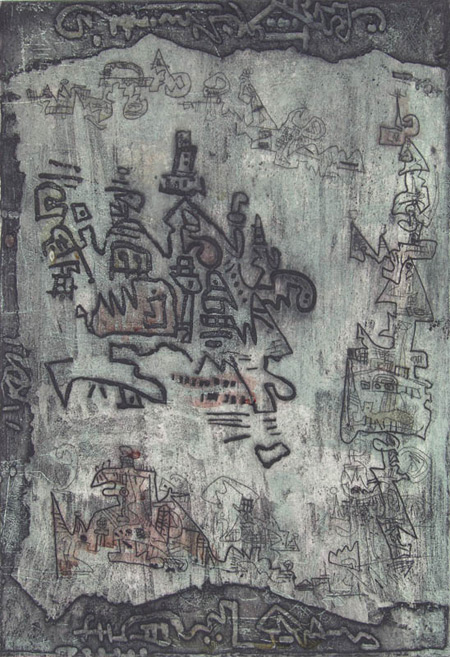
Continuing through March 29, 2013
The restlessness and the wonder that lie at the heart of the traveler are key themes in the work of artist Ynez Johnston. Her prints and paintings are schematics of stacked and layered cities – cities on the hill and those surrounded by water; cities of turrets, towers, and spires. These are not just any cities, these are magical cities, fabled cities like the ones Marco Polo might have heard about before he traveled thousands of miles to find the court of Kublai Khan in China. Then two decades later, upon his return to Venice, Polo himself would spin his own tales of glory and splendor for posterity. Johnston’s fertile imagination is filled with these cities, the ones we imagine the famed explorer describing as he recalled wondrous experiences of his youth and perhaps embellished upon them.
In this small but choice selection titled “Ynez Johnston: An Intimate View,” there is in fact, a print called “Marco Polo.” Done in 1962, it is a version of “Cnossos” which had been done a year before. Both have the same etched image - a magical city on a hill, with tall ships anchored off the coast. The color wipe she used in the two prints is different. “Marco Polo” has a green bordering on chartreuse background tint, while “Cnossos” has a bluish one - both colors of the sea. (Johnston had been to Greece, and perhaps she also visited Knossos, the city on the island of Crete that was center of the great Minoan civilization.) The titles reflect her free-association with travel, the highly romanticized kind that was in vogue in the U.S. and Europe in the 19th century. The traveler was self-consciously aware of seeking the Other, which could be a source of delight and perhaps even of enlightenment. The exoticization of the Other, of course, has its pitfalls and unsavory aspects, as Edward Said detailed in his famous book, "Orientalism," but it seems to me Johnston is innocent of stereotyping and racism. In the context of this work rather than a feeling of superiority, she conveys wonder and a certain longing.
Born in Berkeley, Johnston earned an MFA from UC Berkeley, quite an accomplishment for a woman in 1946. A few years later she moved to Los Angeles, where she still resides. Johnston clearly loved living and traveling abroad. In the early 1940s she spent some time in Mexico, then later travelled to Europe, India, Southeast Asia and Japan, often on fellowships and grants. The very titles of her work are like entries in a travel diary – “Straits of Messina,” “Crossing the Date Line,” “Tribal Coast.” Johnston has enjoyed a bit of a rediscovery in the last few years, especially after an exhibition at the Mingei Museum in San Diego last year.
She is best known for her prints, and the ones here are small to medium-sized. The show also includes three unique works – a pair of paintings (“Untitled,” “Straits of Messina”) and an ink drawing, “Abstraction with Fish” (1947). The earliest work in the show, it already reflects her propensity for covering surfaces. This is her characteristically obsessive approach to composition, which makes even modest-sized works seem to hold a small and mysterious universe. Yes, she exoticizes, but she also exalts. Some early work, such as “Tomb of the Rajah,” are architectural and detailed in their neat stacking of buildings. "Rajah" is a black-and-white etching, as she frequently worked at the time in monochromes or muted colors. Later she increasingly expanded her color range. A print she did for LACMA in 1981, “The Cosmic Mountain,” is bold and bright. The inset panel depicts a mountain island that is surrounded by a bright turquoise sea. It sits within a decorated border of red, which is in turn surrounded by a frame of orange. These works are packed with delightful details, including human figures and animals. One can spin all kinds of narratives into them, and even begin to feel a bit of wanderlust.
Published courtesy of ArtSceneCal ©2013
